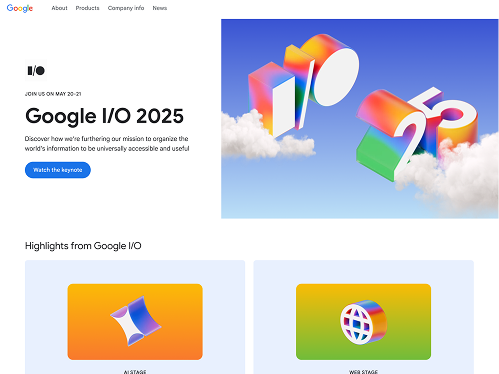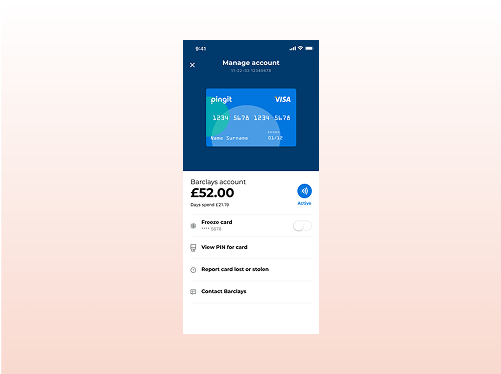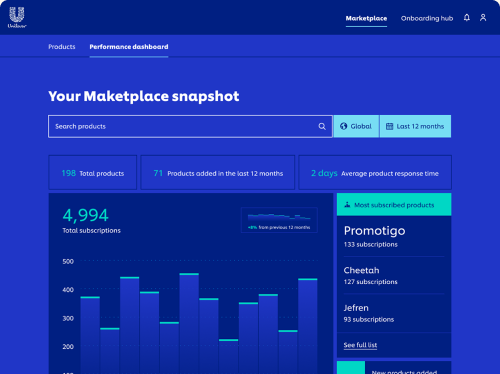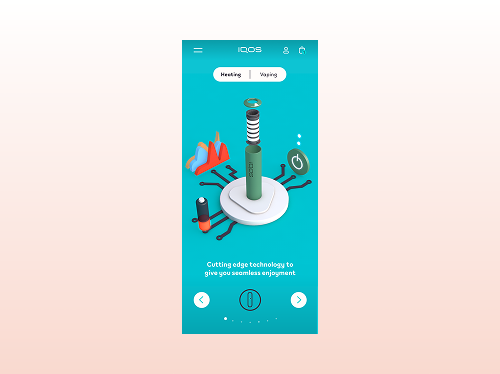
Premier Inn
Creating a new SaaS solution
I led the design to combine two outdated products into a new B2B finance and booking customer experience for the UK’s biggest hotel chain.
Our solution streamlined the sign up journey, provided effective management tools, and greatly reduced inactive accounts.
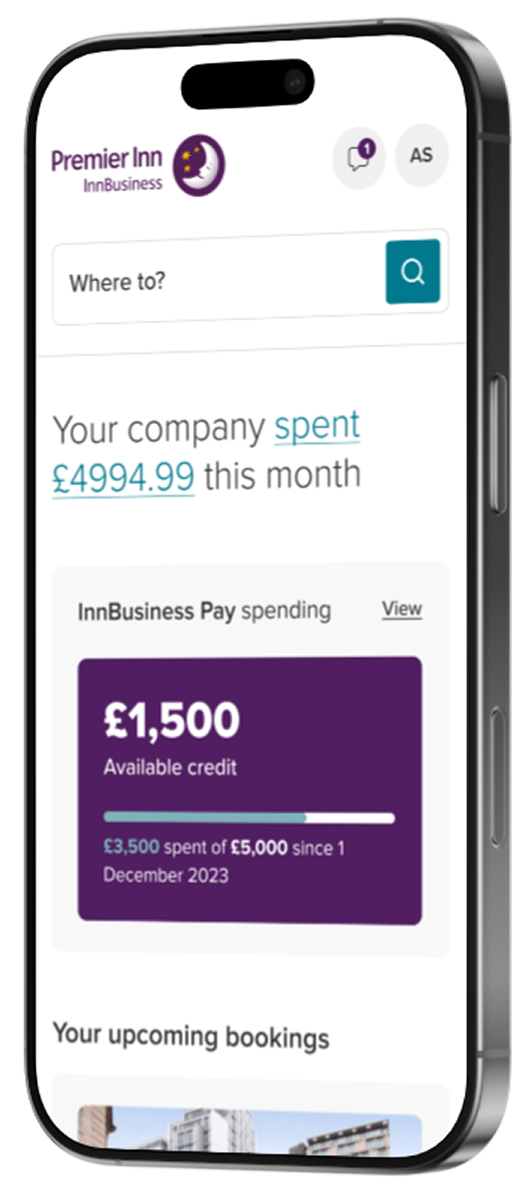
The challenge
Maintaining two separate business products had created a disjointed user experience, resulting in high levels of abandoned accounts – around 70% – and unused features.
Our goal was to create a unified platform combining credit applications, employee management, and business bookings while reducing drop-off rates.
My responsibilities
- Established a process to go from initial brief to engineer handover
- Led the design of a North Star experience
- Translated North Star into an MVP that answers Day One business needs
- Established product priorities with business analysts and stakeholders
- Supported expansion of the design system
The team
Reporting into the Group Head of E-Commerce, I led a team of product designers and content designer. Collaborating with product owners, tech architects, business analysts, research teams and engineers.
The process
1/5
Establishing a process and defining the problem
Looking to create a new product, Working with project managers, my first step was to formalise a process that runs from definition through to delivery.
my first step was to introduce a formal process that could take us from problem definition through to delivery.
From this, I conducted stakeholder and customer workshops, combining outputs with desk research to establish journey maps, pain points and priorities.
Key issues
- The existing solution split essential features across separate sites with no clear navigation
- The split also caused a duplication of functionality, such as employee management, which required management across both sites
- A one-size-fits-all approach failed to serve diverse users, from large businesses to independent contractors,.

I proposed a process based on the double diamond, outlining key actions, timelines and inputs from required teams
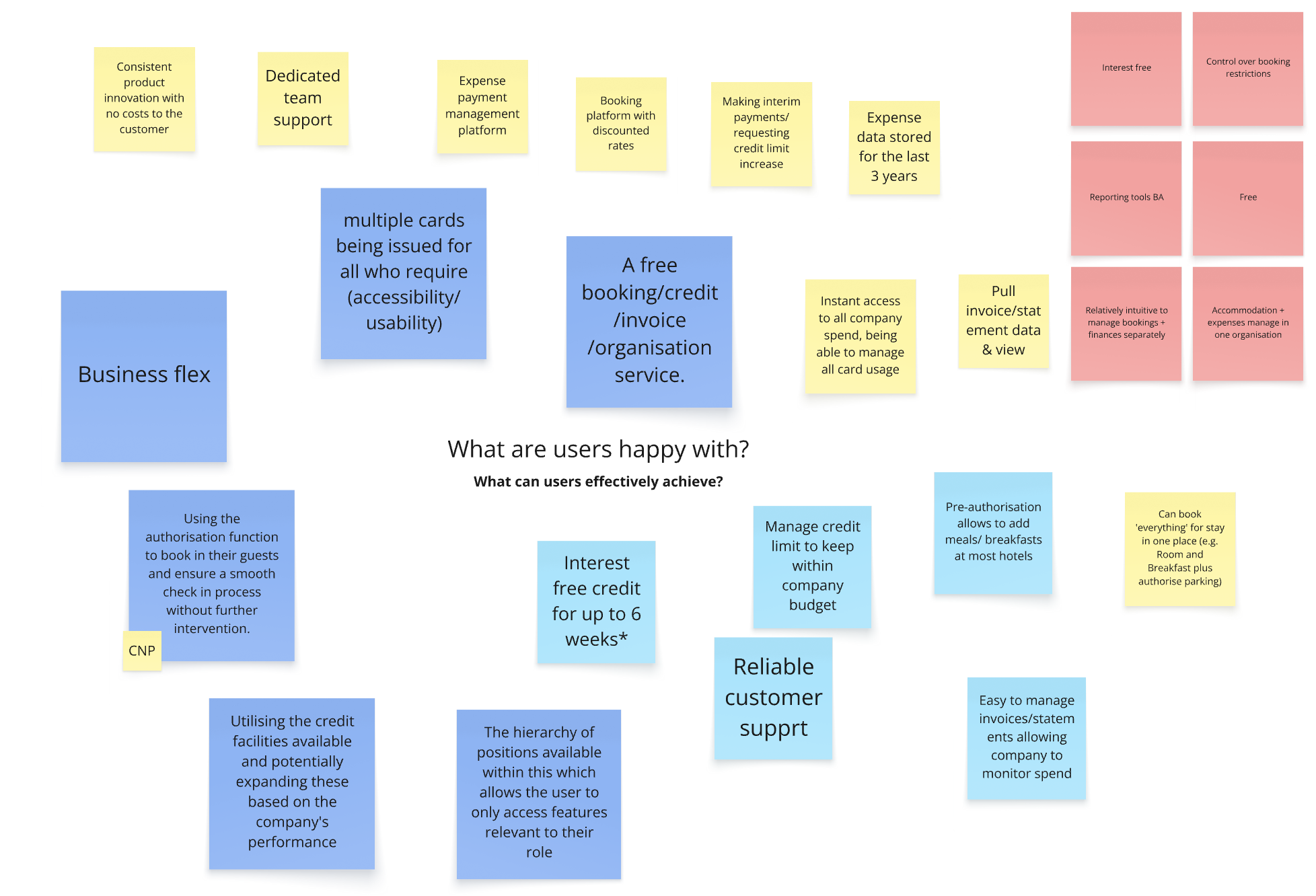
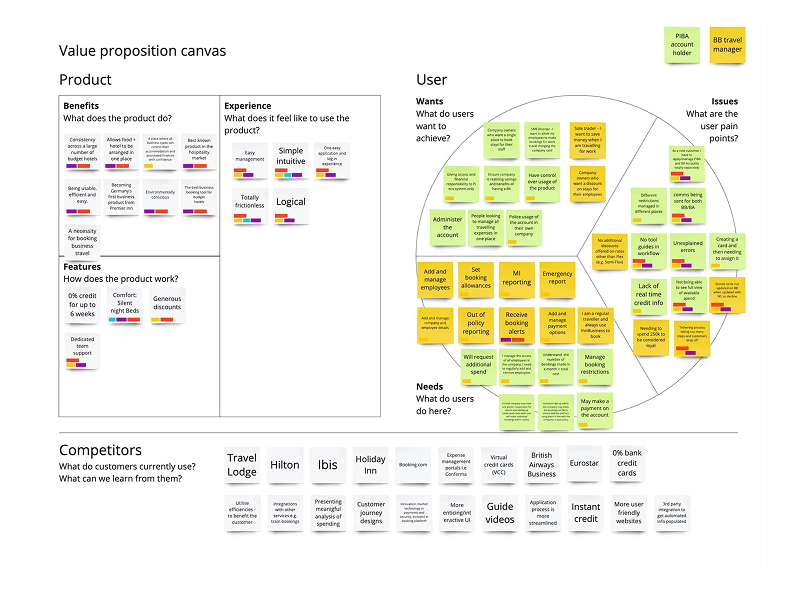
I ran workshops to understand use of the existing solutions, I then mapped responses onto value proposition canvases
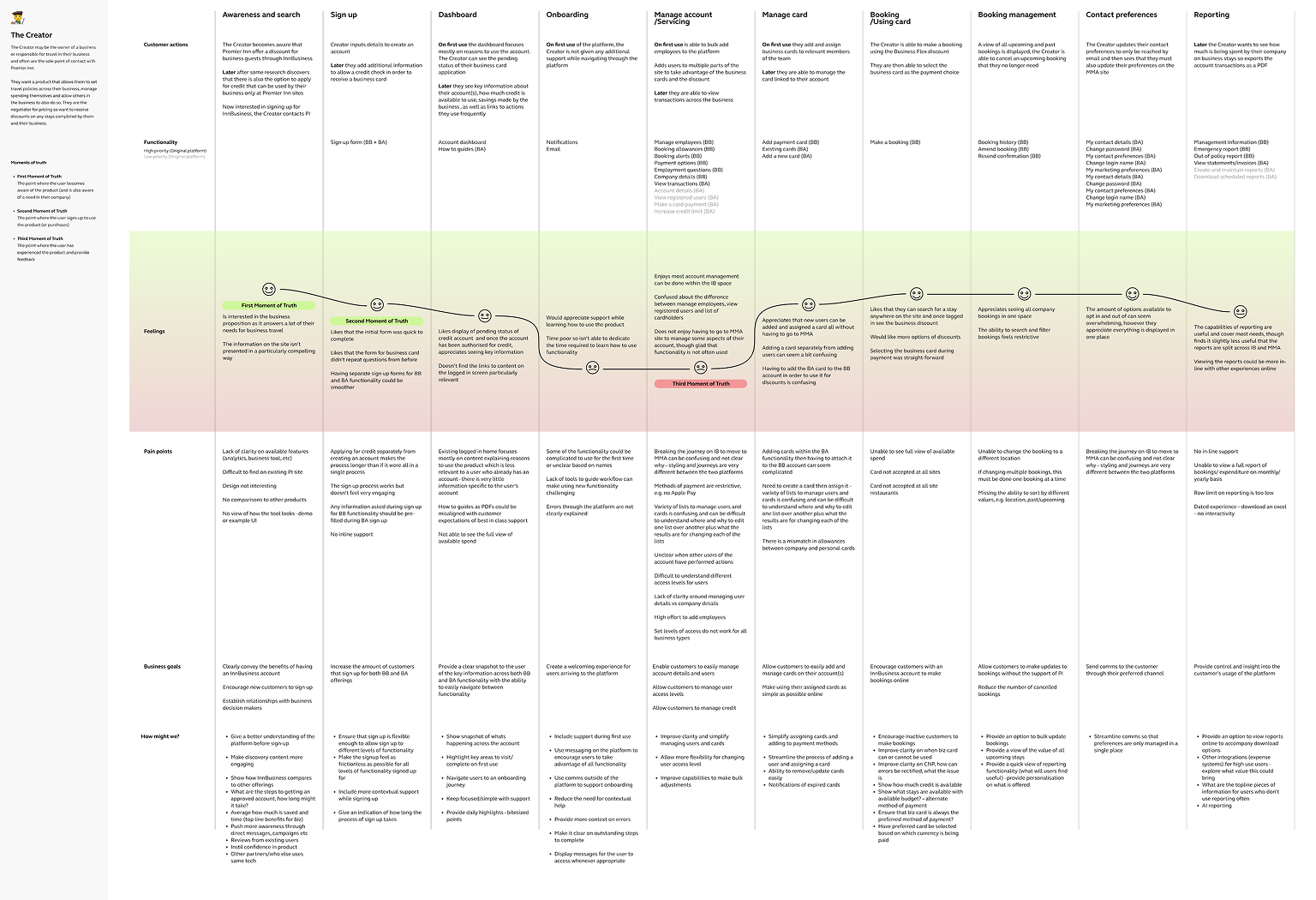
I created journey maps for each user type
2/5
Exploring quick wins – what didn’t work?
Our initial solutions explored elevating the existing products, maintaining the established site structure and interaction patterns. This was driven by the business looking to find options for a quick update.
This approach failed to resolve key issues; maintaining existing structures from both products couldn't create a unified experience, and the duplication of functionality and confusing journeys remained.
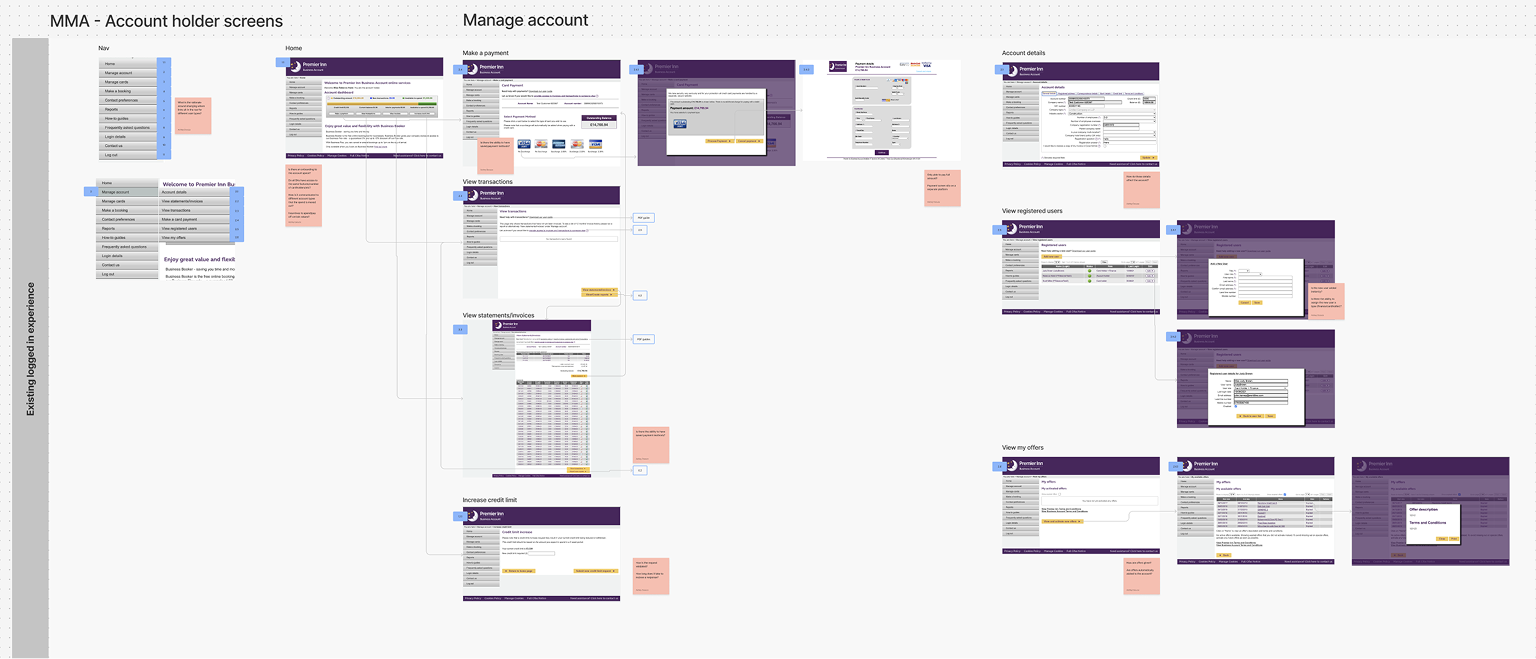
I mapped out the existing products, indicating connections and variations in access
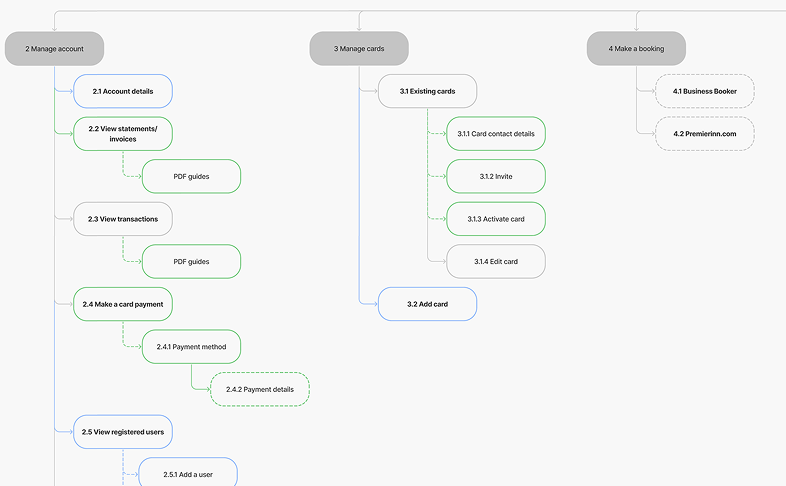
I used the mapping exercise to define the existing sitemaps for all access levels
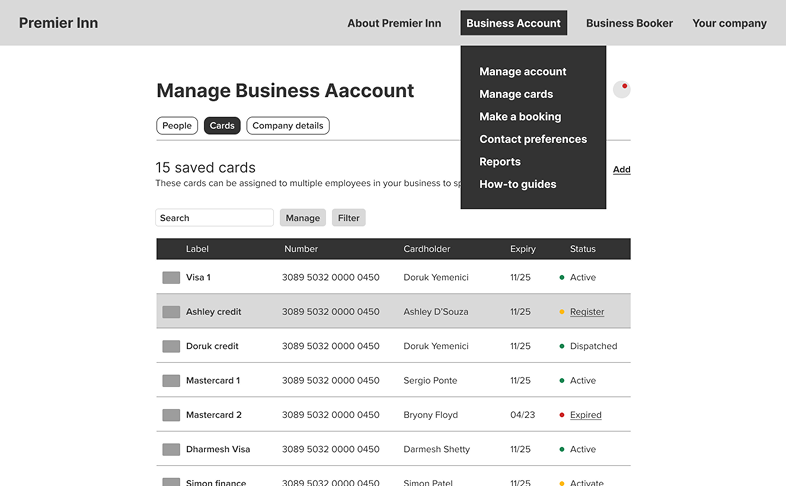
We created wireframes, sticking closely to the existing experience
3/5
Concepting a better solution
Taking learnings from the first iteration of design, we began to shape the North Star concept around the key user moments: booking, financial management, and operational tools. This created a clear proposition that aligns with user needs.
I collaborated with stakeholders and technical architects to define core flows, created an ideal site map, and developed wireframes for different user types and access levels.
My focus was on combining features into a clearer structure to resolve the fractured experience of the previous attempt.
We explored structures for new features which I then modelled into experience flows
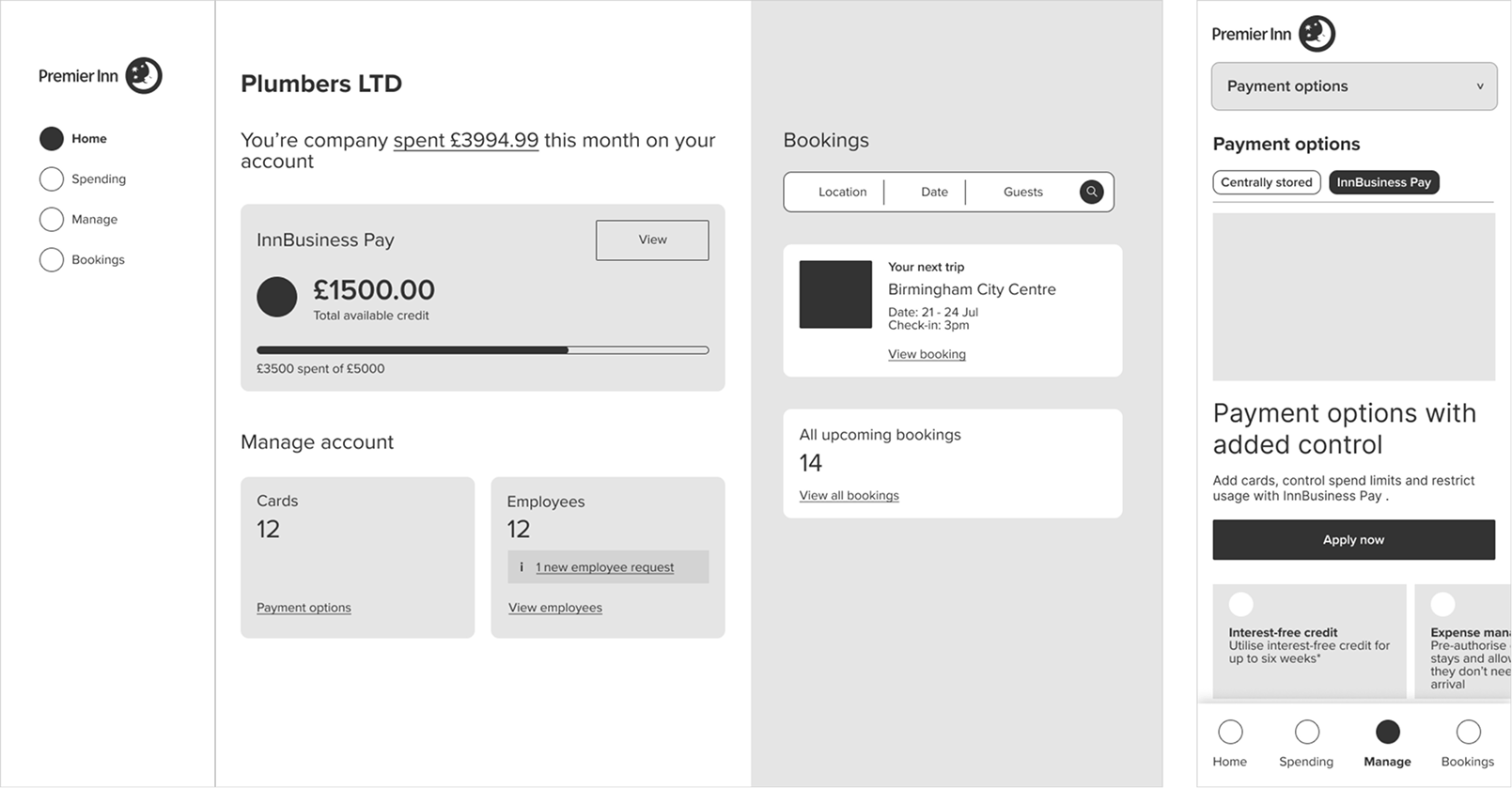
We translated flows into lo-fi wireframes, through the review cycle we added more detail to the wires
4/5
Testing
Once we had an approach that achieved a unified structure, we developed prototypes and test scripts for the core journeys. We then partnered with insights teams to conduct user testing.
Key findings
- Users responded positively to content grouped into three main areas: spending, management, and booking
- Clear, direct language outperformed branded terminology
- Navigation between main site and business platform revealed brand inconsistencies
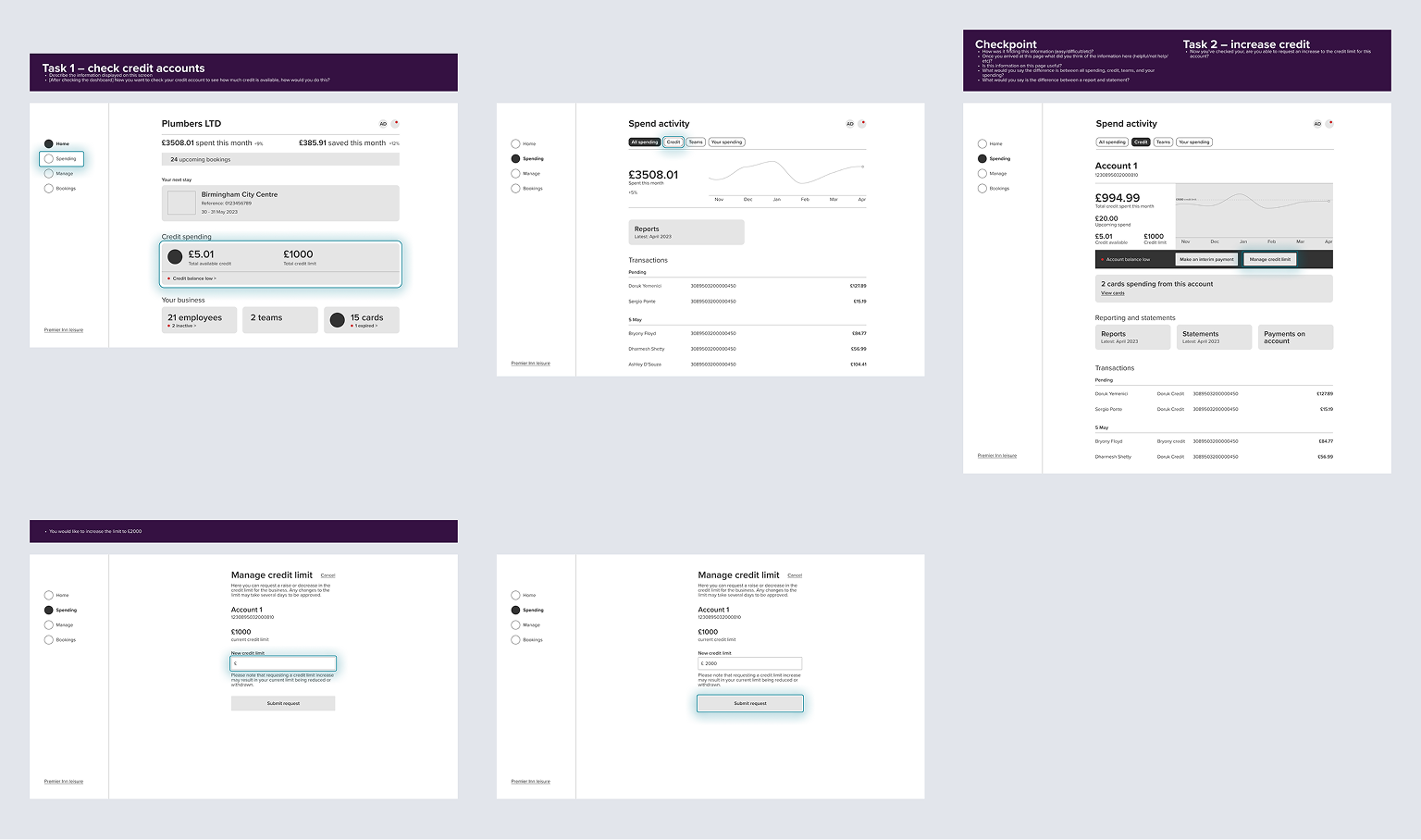
We created prototypes initially as wireframes with accompanying script and prompts
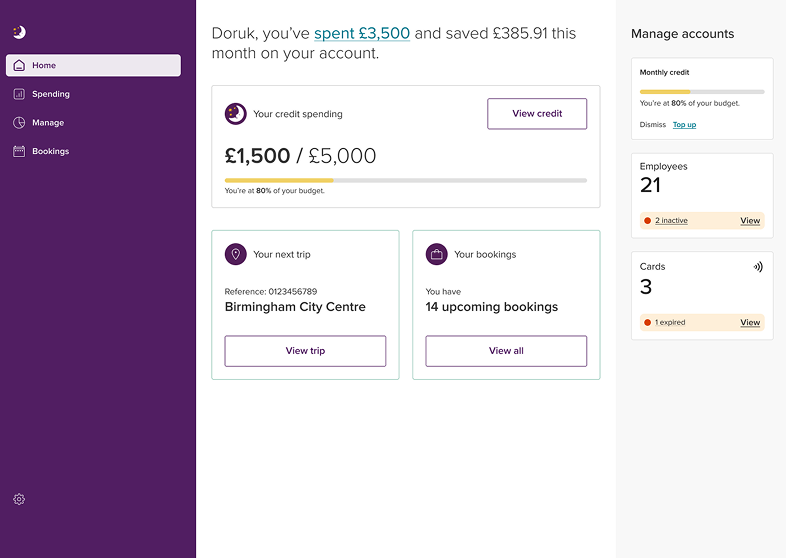
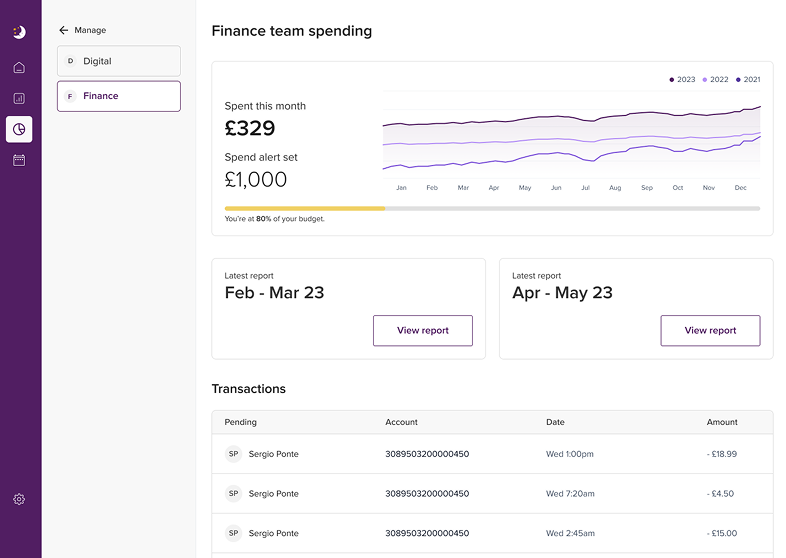
We added definition to the prototypes, exploring the application of the brand
5/5
Defining a Day One product that scales to North Star
Working with stakeholders, tech architects, engineers, and product owners, we scoped our Day One product features.
During design of the Day One product, I pushed for a structure that could expand to fit North Star functionality, ensuring each future iteration would build meaningfully towards the North Star.
Our finalised designs were based on the existing design system, any additions we created focussed on accommodating financial tools and more detailed management of data that wasn’t required on B2C site. To update the design system to include the new functionality we introduced and documented the new templates and components.
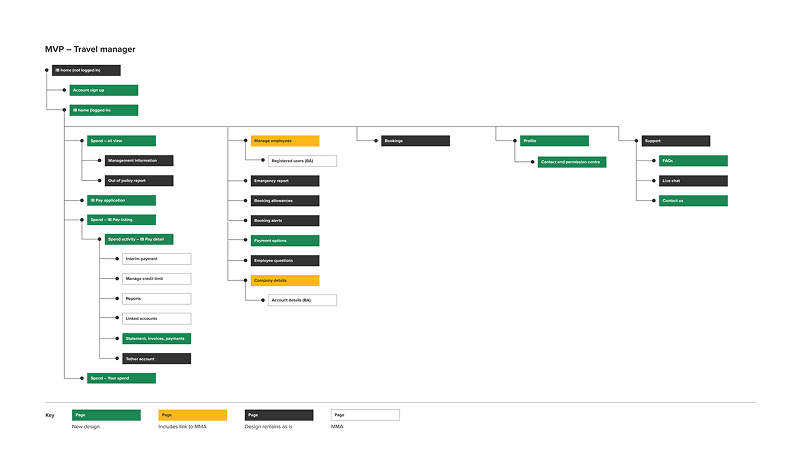
I designed the sitemap with clear path to North Star
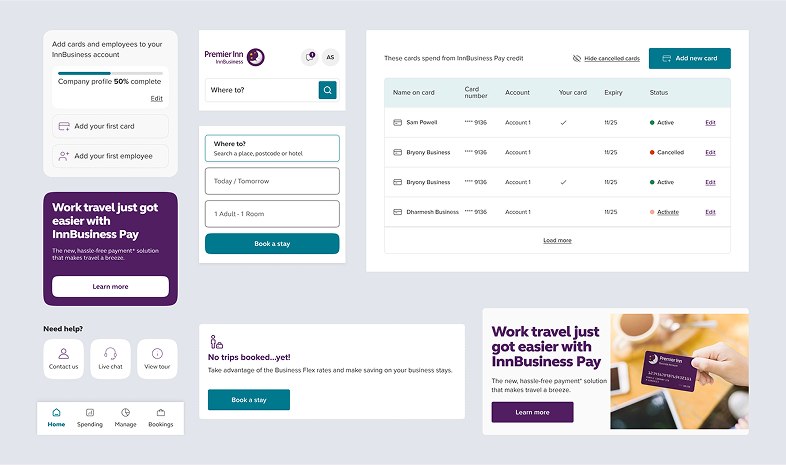
We added the new components to the design system
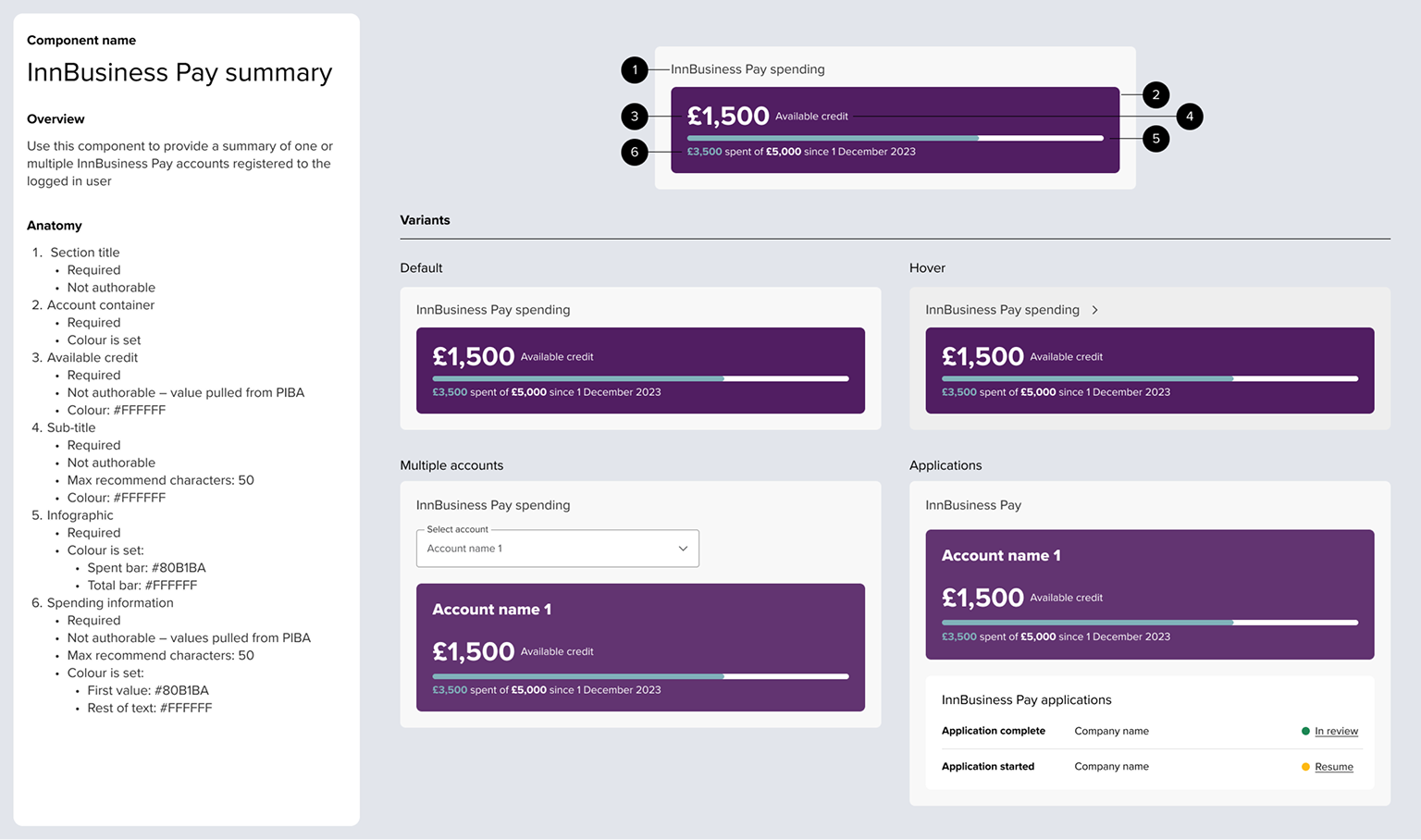
We documented new components and ran handovers with engineering team
The outcome
Product impact
The MVP reduced application time by 58% while eliminating manual validation requirements and streamlined the entire onboarding process.
All duplicated functionality was removed.
User experience
We significantly improved product comprehension and navigation through a focused structure around key functionality, and clearer wayfinding throughout the product.
Brand and business influence
We successfully piloted a refreshed digital application of the Premier Inn brand, aligning closer with above-the-line materials. This initiated a broader exploration to transform the digital experience across the organisation.
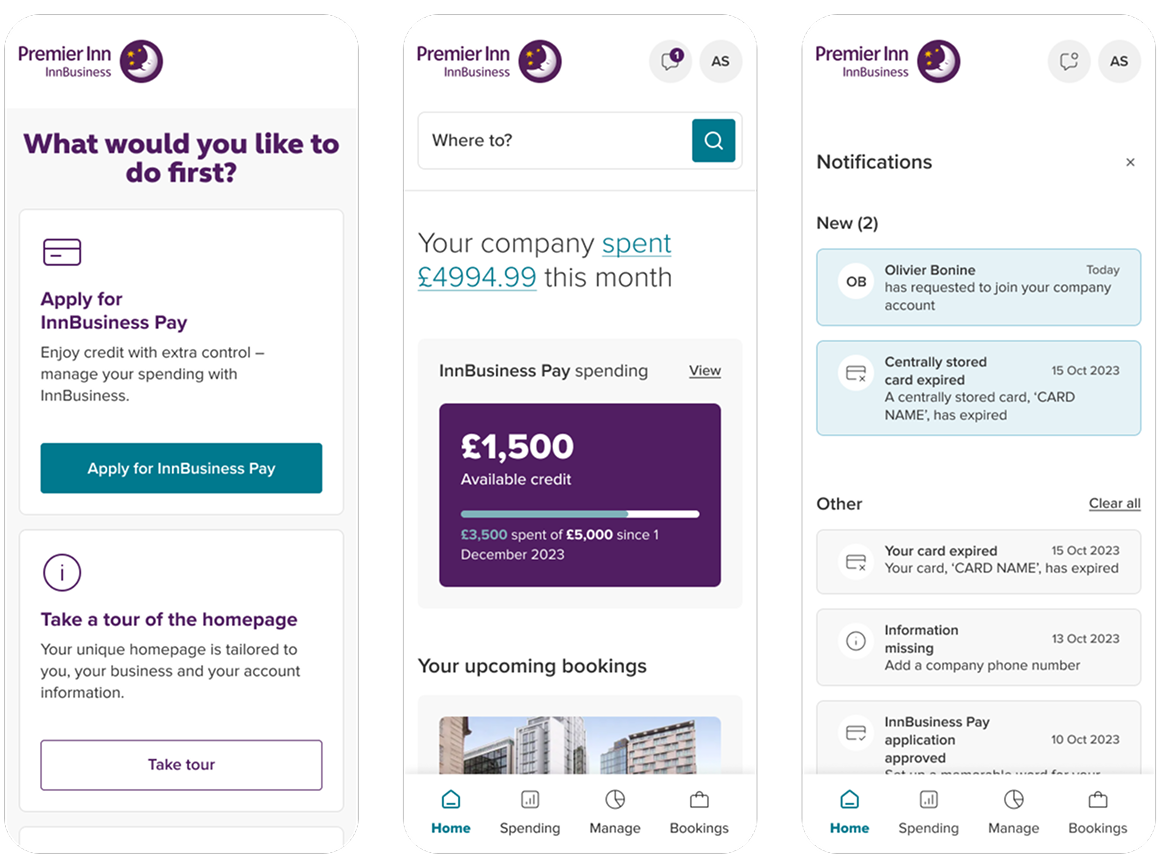
Next up
Let’s connect ashleydanieldsouza@gmail.com
Case studies

Premier Inn
Creating a new SaaS solution
I led the design to combine two outdated products into a new B2B finance and booking customer experience for the UK’s biggest hotel chain.
Our solution streamlined the sign up journey, provided effective management tools, and greatly reduced inactive accounts.

The challenge
Maintaining two separate business products had created a disjointed user experience, resulting in high levels of abandoned accounts – around 70% – and unused features.
Our goal was to create a unified platform combining credit applications, employee management, and business bookings while reducing drop-off rates.
My responsibilities
- Established a process to go from initial brief to engineer handover
- Led the design of a North Star experience
- Translated North Star into an MVP that answers Day One business needs
- Established product priorities with business analysts and stakeholders
- Supported expansion of the design system
The team
Reporting into the Group Head of E-Commerce, I led a team of product designers and content designer. Collaborating with product owners, tech architects, business analysts, research teams and engineers.
The process
1/5
Establishing a process and defining the problem
Looking to create a new product, Working with project managers, my first step was to formalise a process that runs from definition through to delivery.
my first step was to introduce a formal process that could take us from problem definition through to delivery.
From this, I conducted stakeholder and customer workshops, combining outputs with desk research to establish journey maps, pain points and priorities.
Key issues
- The existing solution split essential features across separate sites with no clear navigation
- The split also caused a duplication of functionality, such as employee management, which required management across both sites
- A one-size-fits-all approach failed to serve diverse users, from large businesses to independent contractors,.

I proposed a process based on the double diamond, outlining key actions, timelines and inputs from required teams


I ran workshops to understand use of the existing solutions, I then mapped responses onto value proposition canvases

I created journey maps for each user type
2/5
Exploring quick wins – what didn’t work?
Our initial solutions explored elevating the existing products, maintaining the established site structure and interaction patterns. This was driven by the business looking to find options for a quick update.
This approach failed to resolve key issues; maintaining existing structures from both products couldn't create a unified experience, and the duplication of functionality and confusing journeys remained.

I mapped out the existing products, indicating connections and variations in access

I used the mapping exercise to define the existing sitemaps for all access levels

We created wireframes, sticking closely to the existing experience
3/5
Concepting a better solution
Taking learnings from the first iteration of design, we began to shape the North Star concept around the key user moments: booking, financial management, and operational tools. This created a clear proposition that aligns with user needs.
I collaborated with stakeholders and technical architects to define core flows, created an ideal site map, and developed wireframes for different user types and access levels.
My focus was on combining features into a clearer structure to resolve the fractured experience of the previous attempt.
We explored structures for new features which I then modelled into experience flows

We translated flows into lo-fi wireframes, through the review cycle we added more detail to the wires
4/5
Testing
Once we had an approach that achieved a unified structure, we developed prototypes and test scripts for the core journeys. We then partnered with insights teams to conduct user testing.
Key findings
- Users responded positively to content grouped into three main areas: spending, management, and booking
- Clear, direct language outperformed branded terminology
- Navigation between main site and business platform revealed brand inconsistencies

We created prototypes initially as wireframes with accompanying script and prompts


We added definition to the prototypes, exploring the application of the brand
5/5
Defining a Day One product that scales to North Star
Working with stakeholders, tech architects, engineers, and product owners, we scoped our Day One product features.
During design of the Day One product, I pushed for a structure that could expand to fit North Star functionality, ensuring each future iteration would build meaningfully towards the North Star.
Our finalised designs were based on the existing design system, any additions we created focussed on accommodating financial tools and more detailed management of data that wasn’t required on B2C site. To update the design system to include the new functionality we introduced and documented the new templates and components.

I designed the sitemap with clear path to North Star

We added the new components to the design system

We documented new components and ran handovers with engineering team
The outcome
Product impact
The MVP reduced application time by 58% while eliminating manual validation requirements and streamlined the entire onboarding process.
All duplicated functionality was removed.
User experience
We significantly improved product comprehension and navigation through a focused structure around key functionality, and clearer wayfinding throughout the product.
Brand and business influence
We successfully piloted a refreshed digital application of the Premier Inn brand, aligning closer with above-the-line materials. This initiated a broader exploration to transform the digital experience across the organisation.

Next up
Let’s connect ashleydanieldsouza@gmail.com
Case studies

Premier Inn
Creating a new SaaS solution
I led the design to combine two outdated products into a new B2B finance and booking customer experience for the UK’s biggest hotel chain.
Our solution streamlined the sign up journey, provided effective management tools, and greatly reduced inactive accounts.

The challenge
Maintaining two separate business products had created a disjointed user experience, resulting in high levels of abandoned accounts – around 70% – and unused features.
Our goal was to create a unified platform combining credit applications, employee management, and business bookings while reducing drop-off rates.
My responsibilities
- Established a process to go from initial brief to engineer handover
- Led the design of a North Star experience
- Translated North Star into an MVP that answers Day One business needs
- Established product priorities with business analysts and stakeholders
- Supported expansion of the design system
The team
Reporting into the Group Head of E-Commerce, I led a team of product designers and content designer. Collaborating with product owners, tech architects, business analysts, research teams and engineers.
The process
1/5
Establishing a process and defining the problem
Now looking to create a new product, my first step was to formalise a process that runs from definition through to delivery, working with product owners and project managers to get company buy-in.
From this, I conducted stakeholder and customer workshops, combining outputs with desk research to establish journey maps, pain points and priorities.
Key issues
- The existing solution split essential features across separate sites with no clear navigation
- The split also caused a duplication of functionality, such as employee management, which required management across both sites
- A one-size-fits-all approach failed to serve diverse users, from large businesses to independent contractors,.

I proposed a process based on the double diamond, outlining key actions, timelines and inputs from required teams


I ran workshops to understand use of the existing solutions, I then mapped responses onto value proposition canvases

I created journey maps for each user type
2/5
Exploring quick wins – what didn’t work?
Our initial solutions explored elevating the existing products, maintaining the established site structure and interaction patterns. This was driven by the business looking to find options for a quick update.
This approach failed to resolve key issues; maintaining existing structures from both products couldn't create a unified experience, and the duplication of functionality and confusing journeys remained.

I mapped out the existing products, indicating connections and variations in access

I used the mapping exercise to define the existing sitemaps for all access levels

We created wireframes, sticking closely to the existing experience
3/5
Concepting a better solution
Taking learnings from the first iteration of design, we began to shape the North Star concept around the key user moments: booking, financial management, and operational tools. This created a clear proposition that aligns with user needs.
I collaborated with stakeholders and technical architects to define core flows, created an ideal site map, and developed wireframes for different user types and access levels.
My focus was on combining features into a clearer structure to resolve the fractured experience of the previous attempt.
We explored structures for new features which I then modelled into experience flows

We translated flows into lo-fi wireframes, through the review cycle we added more detail to the wires
4/5
Testing
Once we had an approach that achieved a unified structure, we developed prototypes and test scripts for the core journeys. We then partnered with insights teams to conduct user testing.
Key findings
- Users responded positively to content grouped into three main areas: spending, management, and booking
- Clear, direct language outperformed branded terminology
- Navigation between main site and business platform revealed brand inconsistencies

We created prototypes initially as wireframes with accompanying script and prompts


We added definition to the prototypes, exploring the application of the brand
5/5
Defining a Day One product that scales to North Star
Working with stakeholders, tech architects, engineers, and product owners, we scoped our Day One product features.
During design of the Day One product, I pushed for a structure that could expand to fit North Star functionality, ensuring each future iteration would build meaningfully towards the North Star.
Our finalised designs were based on the existing design system, any additions we created focussed on accommodating financial tools and more detailed management of data that wasn’t required on B2C site. To update the design system to include the new functionality we introduced and documented the new templates and components.

I designed the sitemap with clear path to North Star

We added the new components to the design system

We documented new components and ran handovers with engineering team
The outcome
Product impact
The MVP reduced application time by 58% while eliminating manual validation requirements and streamlined the entire onboarding process.
All duplicated functionality was removed.
User experience
We significantly improved product comprehension and navigation through a focused structure around key functionality, and clearer wayfinding throughout the product.
Brand and business influence
We successfully piloted a refreshed digital application of the Premier Inn brand, aligning closer with above-the-line materials. This initiated a broader exploration to transform the digital experience across the organisation.

Next up
Let’s connect ashleydanieldsouza@gmail.com
